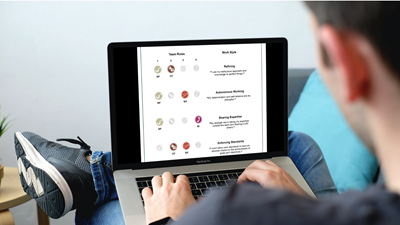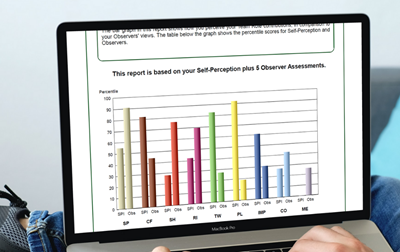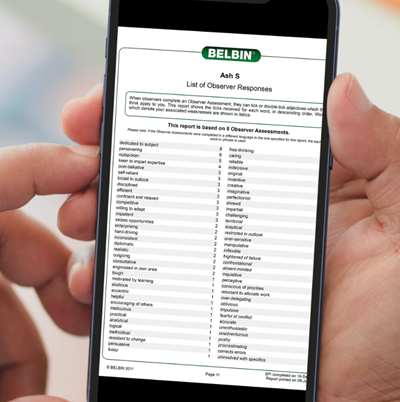Your leadership journey begins with understanding your strengths: your superpowers
The Belbin Individual Report identifies your leadership strengths – the areas that characterise your distinctive leadership style. But understanding these strengths isn’t simply a case of patting yourself on the back and ignoring all else. It means acknowledging and celebrating those styles which come most naturally, and recognising the loss which accompanies this: that no one person has a natural affinity for every strength. Your leadership style may be different to your aspiration. It may not mirror that of a role model or other effective leaders you’ve encountered, but that’s OK. Because you’ll be working and leading authentically, growing within your own style and cultivating it without compromising the very strengths that led you to the role in the first place.
"Individuals do not make good carbon copies of one another but only pale shadows whenever they attempt to imitate."
Meredith Belbin | Team Roles at Work

Find your superpowers
Your leadership superpowers are tucked away in your Belbin Individual Report. Moving beyond the characteristics of your individual Team Role strengths, the ‘Suggested Work Styles’ page of your report identifies your top four Belbin Team Roles in various combinations and offers words and phrases which summarise – and help you articulate – your approach.
In this example, Ash is a determined, self-reliant leader who can see how to make things better and possesses the dynamism and expertise to bring the team along too.
Learn how to flex without pulling yourself out of shape
When working on understanding your strengths through the lens of leadership, the trick is to find the ‘quick wins’. These are the ways you can flex your style to lead your team and connect with them in the most meaningful way, without trying to pick up other attributes that risk pulling you out of shape altogether. Looking at Ash’s Self and Observer Perceptions, others see less of the detail focus than Ash does, and more of the entrepreneurial spirit – the enthusiasm, drive and ability to make important business decisions at pace.
So, how can we use these insights to inform Ash’s leadership style?
In this case, there is some disparity between Ash’s perception and the strengths others see. We can use the ‘List of Observer Responses’ to drill down into the detail and make a strategic plan.


Formulate your leadership growth plan
Observers don’t see Ash’s accuracy and detail focus, so perhaps there are other qualities that Ash can draw on from amongst the top four Team Roles? In her webinar on authentic leadership, Lindsay Lalla, described how leaders might use their ‘List of Observer Words’ – the collated feedback from colleagues within the Belbin Report – to choose two strengths to cultivate and two weaknesses to manage, in pursuit of a more effective leadership style.
Observers see lots of positive Shaper behaviours, but don’t see Ash as challenging, so one of Ash’s goals could be to hone those Shaper strengths further by considering how work can be presented in a way that will engage and inspire people.
When it comes to Completer Finisher qualities, accuracy and the ability to spot errors are amongst the lowest on Ash’s list, so it may not be worth investing effort in trying to improve in these areas. The most likely outcome is that Ash’s other strengths would simply be dulled while efforts were focused elsewhere. Others in the team might be more naturally suited to the focused, detail-oriented work, leaving Ash free to pursue new opportunities and lead from the front.
Whilst Observers see some positive Resource Investigator attributes, Ash has a high score for over-talkative, relative to strengths for that role. So, Ash might be able to accommodate colleagues by making a conscious effort to speak less and hear what others have to say.
Getting to work
Once you have the evidence about your own leadership style and an action plan, the next step is to put your learning into practice and supercharge your superpowers. It isn’t enough for Ash to declare an intention to be more challenging, or to leave the Completer Finisher work for someone else.
How will these changes look in practice? What needs to be put in place to ensure that things change? Who can Ash approach for help?
This is where the rest of the team comes in. A great leader knows team members’ strengths and can call on others to contribute according to those strengths. What’s more, there is mutual trust and shared accountability, so others are engaged in the success of a project alongside the leader. If you’re looking to discover your team’s strengths, the Belbin Team Report is a great place to start. It offers an overview of the team’s balance and culture, and can help you decide where to turn when seeking diverse contributions.
A snapshot in time
Belbin is a snapshot of your strengths at a particular time. We are all capable of modifying our behaviours according to our situation. That’s what sets Belbin apart from personality tests, which measure fixed assets.
Belbin describes not the noun of who you are, but the verb of what you do.
And the outcomes are measurable. As we strive to make conscious changes to our behaviour – to hone our role as a leader, or to communicate more effectively with colleagues – it’s important to review the success of our efforts. Six months later, can we see the differences? Can others? Are we articulating our strengths more clearly and working towards a more cohesive leadership style?
Where to start
Are you ready to discover your leadership superpowers? The Belbin Individual Report is the place to start. Or perhaps you and your leadership team have taken this first step and need to understand how all the pieces fit together? The Belbin Team Report is your next port-of-call.
Not sure what you need? Our small, friendly team is only a phone call away.
Discover individual and team strengths using Belbin Team Role reports

Belbin Individual Reports
Before you can analyse your teams, you need to look at each individual's contribution. So, the first thing you will need to do is to generate a Belbin Individual report for each member of the team.
Find out more
Belbin Team Reports
Whether you're forming a new team, introducing new people to an existing team, or trying to resolve issues within a team, a Belbin Team report can help you to manage it.
Discover more
Why Use Belbin?
Belbin Team Roles are used to identify behavioural strengths and weaknesses in the workplace. Whether developing people, resolving conflict or fine-tuning high performance...
Read moreGet our latest thoughts and research straight to your inbox!